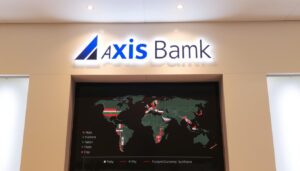Did you know that over $150 billion is transferred globally every day? In today’s interconnected world, efficient money transfers are crucial for businesses and individuals alike. Understanding the timelines for processing these transactions can make a significant difference in financial planning.
Axis Bank plays a vital role in facilitating global financial transactions. Its services are designed to meet the needs of customers sending or receiving funds across borders. However, the duration of these transfers can vary based on several factors, including the transfer method and destination country.
For those seeking faster alternatives, solutions like Karbon FX offer streamlined processes. Knowing your options ensures you can choose the best method for your needs.
Key Takeaways
- Global money transfers exceed $150 billion daily.
- Axis Bank is a key player in international financial transactions.
- Processing times depend on transfer methods and destinations.
- Understanding timelines is essential for effective financial planning.
- Alternative solutions like Karbon FX provide faster processing options.
Understanding Axis Bank’s International Payment Process
In a globalized economy, transferring funds across borders is essential for businesses and individuals. International payments allow seamless movement of money between countries, enabling trade, investments, and personal remittances. These transactions involve converting one currency into another and ensuring compliance with regulatory frameworks.
What Are International Payments?
International payments refer to the transfer of funds from one bank account in a specific country to another in a different country. These transactions are crucial for global trade, remittances, and investments. They often involve converting foreign currency to facilitate the transfer.
Key aspects of international payments include:
- Use of SWIFT/BIC codes for secure and efficient transfers.
- Compliance with local and international regulations, such as RBI guidelines.
- Support for multiple currencies, including USD, EUR, and GBP.
Axis Bank’s Role in Cross-Border Transactions
Axis Bank plays a pivotal role in facilitating cross-border transactions. With its robust infrastructure, the bank ensures secure and efficient transfers. It supports over 40 currencies, making it easier for customers to send money globally.
The bank’s integration with correspondent banking networks enhances its global reach. This ensures that funds are transferred swiftly and securely, even to remote locations. Additionally, Axis Bank adheres to strict RBI guidelines, ensuring compliance and security in every transaction.
How Long Does Axis Bank Take to Process International Payments?
Timely financial transactions are critical in today’s fast-paced global economy. For those relying on Axis Bank, understanding the processing timelines can help in planning and avoiding delays. The duration varies depending on the transfer method and other external factors.
Processing Times for Different Transfer Methods
Axis Bank offers multiple channels for sending funds abroad. Each method has its own processing timeline:
- Internet Banking: 2-5 business days.
- Mobile Banking: 2-5 business days.
- Branch Visits: 3-5 business days.
While these timelines are standard, delays can occur due to weekends, holidays, or additional compliance checks.
Factors Affecting Processing Duration
Several elements can influence how quickly a transfer is completed. Currency conversion requirements often add extra time, especially for less common currencies. Compliance checks and documentation verification are also crucial steps that can delay settlements.
Digital-first providers like moneyHOP offer faster alternatives, with some transfers completed within 24 hours. Comparing these options ensures you choose the most efficient solution for your needs.
Step-by-Step Guide to Sending Money Abroad with Axis Bank
Sending money abroad has never been easier with Axis Bank’s versatile options. Whether you prefer digital platforms or in-person services, the bank ensures a seamless experience. Below, we break down the three primary methods to help you choose the best approach for your needs.
Using Axis Bank Internet Banking
Axis Bank’s internet banking platform is a convenient way to transfer funds globally. Start by logging into your account and navigating to the international payments section. Enter the recipient’s details, including their bank account information and SWIFT/BIC code.
An OTP will be sent to your registered mobile number for authentication. Once verified, confirm the transaction. Keep the transaction reference number for tracking purposes. This method typically takes 2-5 business days to complete.
Using the Axis Mobile App
The Axis Bank mobile app offers a user-friendly interface for international transfers. After logging in, select the “Send Money Abroad” option. Input the recipient’s details and the transfer amount, ensuring it doesn’t exceed the $25,000 per transaction limit.
Authenticate the transaction using the OTP sent to your mobile device. The app also allows you to manage beneficiaries for future transfers. This method is ideal for those who prefer on-the-go banking.
Visiting an Axis Bank Branch
For those who prefer in-person assistance, visiting an Axis Bank branch is a reliable option. Operating hours are from 9:30 AM to 4 PM. Bring all necessary documents, including identification and recipient details.
A bank representative will guide you through the process, ensuring all information is accurate. This method is particularly useful for larger transactions or if you need additional support.
Axis Bank’s Fees and Charges for International Transfers
Understanding the costs involved in international transfers is crucial for effective financial planning. Axis Bank offers a transparent fee structure, but it’s essential to know the details to avoid unexpected expenses. Whether you’re sending USD or other currencies, the charges can vary based on the transfer method and amount.
Breakdown of Fees
Axis Bank’s fee structure for international transfers includes multiple components. For instance, a standard transfer may involve a base fee of Rs. 1000, a SWIFT charge of Rs. 500, and a 0.125% commission on the transaction amount. These charges can add up, especially for larger transfers.
Here’s a quick overview of the costs:
- Base Fee: Rs. 1000 per transaction.
- SWIFT Charge: Rs. 500 for secure transfers.
- Commission: 0.125% of the transaction amount.
Additionally, hidden costs like exchange rate spreads can further increase the total expense. Comparing these fees with alternatives like moneyHOP or Karbon FX can help you find cost-effective solutions.
How to Minimize Transfer Costs
Reducing the costs of sending money India to other countries requires strategic planning. One effective method is to leverage threshold-based fee reductions. For example, bulk transfers often qualify for discounts, making them more economical for businesses.
Here are some tips to minimize expenses:
- Compare exchange rates across platforms to avoid unfavorable spreads.
- Opt for digital-first providers like moneyHOP for lower fees.
- Plan transfers in advance to avoid urgent processing charges.
By understanding the fee structure and exploring alternatives, you can ensure that more of your money reaches its intended destination.
Axis Bank’s Exchange Rates for International Payments
Exchange rates play a pivotal role in the cost and efficiency of global financial transactions. When sending money abroad, even a slight variation in the rate can significantly impact the final amount received. Understanding how these rates are determined and how to secure the best ones is essential for optimizing your transfers.
How Exchange Rates Are Determined
Exchange rates are influenced by a combination of market forces and institutional mechanisms. The interbank rate, set by global financial markets, serves as the baseline. However, banks and financial institutions often add a retail markup, which can vary based on the currency and transaction size.
Key factors affecting exchange rates include:
- Supply and demand for specific foreign currencies.
- Economic indicators like inflation and interest rates.
- Geopolitical events and market speculation.
Tips for Getting the Best Rates
Securing favorable rates requires strategic planning. One effective approach is to monitor market trends and time your transfers during periods of favorable USD or other currency valuations. Platforms like moneyHOP offer rate freezing features, allowing you to lock in a rate for future transfers.
Additional strategies include:
- Opening a multi-currency account to avoid repeated conversions.
- Setting up rate alerts to stay informed about market fluctuations.
- Exploring alternative platforms with lower forex markups.
By leveraging these tips, you can ensure that more of your money reaches its intended destination.
Axis Bank’s Transfer Limits and Restrictions
Navigating the rules and limits of cross-border transactions is essential for seamless financial operations. Axis Bank has established specific limits and guidelines to ensure compliance and security. Understanding these parameters helps individuals and businesses plan their payments effectively.
Daily and Monthly Limits
Axis Bank imposes daily and monthly caps on transactions to align with regulatory requirements. For instance, the mobile app has a limit of $25,000 per transaction. This ensures that users adhere to the Liberalized Remittance Scheme (LRS) guidelines.
Here are some key thresholds:
- Education-related transfers: Up to $250,000 annually.
- Medical payments: Higher thresholds with proper documentation.
- High-value transactions: Additional verification at Axis Bank branches.
Understanding RBI Guidelines
The Reserve Bank of India (RBI) plays a crucial role in shaping cross-border financial policies. Axis Bank strictly follows these guidelines to maintain transparency and security. For example, NRIs have specific allowances and restrictions based on their residency status.
Key aspects of RBI compliance include:
- Documentation for transactions exceeding $10,000.
- Separate rules for business and personal transfers.
- Regular audits to ensure adherence to LRS limits.
By understanding these rules, customers can avoid delays and ensure their payments are processed smoothly.
Exploring Faster Alternatives for International Payments
In today’s fast-paced world, speed is a critical factor in financial transactions. Delays in sending money abroad can disrupt business operations or personal plans. This is why many are turning to faster alternatives for cross-border transfers.
Why Speed Matters in Cross-Border Transactions
Time-sensitive scenarios, such as emergency fund transfers or urgent business payments, demand quick processing. Delays can lead to missed opportunities or financial losses. Faster service ensures that funds reach their destination when needed most.
For instance, platforms like moneyHOP offer 24-hour transfer capabilities, making them ideal for urgent needs. Real-time tracking, as provided by Instarem, adds transparency and peace of mind.
Alternative Solutions for Quicker Transfers
Modern fintech solutions are revolutionizing the way we bank remit money. API-driven platforms reduce processing layers, enabling instant transfers. Prefunded account models further streamline the process by eliminating intermediary delays.
Here are some advantages of these alternatives:
- 24/7 customer support: Platforms like Karbon FX ensure assistance is always available.
- Compliance automation: Advanced systems handle regulatory checks seamlessly, reducing processing time.
- Cost efficiency: Lower fees compared to traditional methods make these options more affordable.
For those seeking faster and more efficient ways to send money, exploring these alternatives is a smart move. Learn more about HDFC Bank’s USD transfer processing time for additional insights.
How to Track Your Axis Bank International Payment
Tracking your cross-border transactions ensures transparency and peace of mind. Whether you’re sending funds for business or personal reasons, knowing the status of your payment is crucial. Axis Bank provides multiple tools and methods to help customers monitor their transactions effectively.
Using Transaction Reference Numbers
Every international transfer generates a unique number known as the transaction reference. This number is essential for tracking the status of your payment. It typically includes details like the transaction date, amount, and recipient information.
Customers can decode the reference number components to understand the transfer’s progress. SMS and email alerts can also be customized to receive real-time updates. If issues arise, Axis Bank offers clear dispute resolution pathways to address concerns promptly.
Real-Time Tracking Tools
Axis Bank integrates advanced tools like SWIFT GPI for real-time tracking. These platforms provide end-to-end visibility, ensuring customers know exactly where their funds are at any given moment. Correspondent bank tracking protocols further enhance this transparency.
The mobile app also allows users to set up notification settings for seamless updates. With these tools, customers can monitor their banking transactions effortlessly, reducing uncertainty and improving the overall experience.
Conclusion
Efficient global transactions are vital for seamless financial operations. Axis Bank offers reliable options for cross-border transfers, with processing times ranging from 2-5 business days. However, costs can vary based on the method and exchange rates applied.
For users prioritizing speed and affordability, fintech solutions like Karbon FX provide competitive advantages. These platforms often deliver faster processing and lower fees, making them ideal for urgent money transfers.
When choosing a method, consider your account needs and transfer urgency. Whether you opt for traditional banking or modern alternatives, understanding the costs and timelines ensures a smoother experience.







